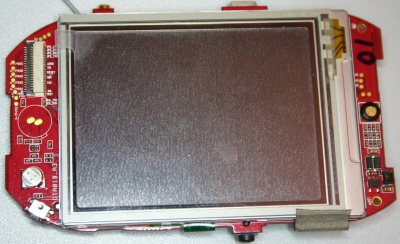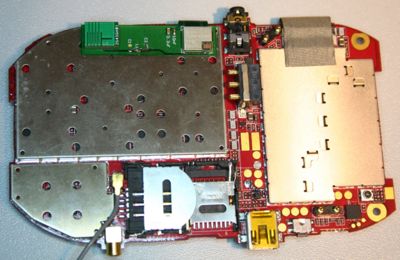Category:Neo1973 Hardware/it
From Openmoko
OpenMoko e' un framework software che si appoggia su una piattaforma hardware. L' Hardware Neo1973 e' la prima piattaforma hardware a trarre il massimo beneficio dalla Distribuzione software OpenMoko. E' possibile trovare le specifiche dell' Hardware Neo1973 analizzando queste pagine introduttive e le altre pagine riguardanti l' Hardware Neo1973 qui' di seguito.
Contents
|
Esperienze degli utenti dell'hardware della Fase 0
Lista dei desideri:Opinioni Neo1973 Fase 0
Dimensioni
- 120.7 x 62 x 18.5 mm (4.75 x 2.44 x 0.728 pollici)
- 184 +/- 5 g (6.5 once)
Componenti principali
Processore
Il Processore principale (CPU) del Neo1973 e' il Samsung S3C2410AL-26 (In grado di funzionare sino a 266 MHz)
- Homepage del prodotto: S3C2410.htm
- Manuale Utente: 2410UserManual.pdf
- File BSDL: S3C2410_BGA_BSDLJTAGFILE.bsd
- Assegnazione degli GPIOs (General Purpose I/Os): https://svn.openmoko.org/trunk/doc/hardware/GTA01Bv3/gpio.txt
Flash
64MB Samsung NAND flash (K9F1208U0B) pilotata da un NAND controller S3C2410.
- Homepage del Prodotto: K9F1208U0B.htm
- Data Sheet: ds_k9f1208x0b_rev03.pdf
- NAND controller: S3C2410
Questa e' l'unica memoria flash del dispositivo. Il S3C2410 esegue il boot direttamente dalla nand, usand il S3C2410 Steppingstone.
Utilizziamo solo software libero, nessun file-system per flash proprietario. Per una descrizione completa su come e' usato, vedere Blocchi difettosi nelle NAND
RAM
128MB SDRAM (2x Samsung K4M511633C) all'SDRAM controller S3C2410
- Homepage del Prodotto: K4M511633C.htm
- Data Sheet: ds_k4m511633c.pdf
- SDRAM controller: S3C2410
GSM/GPRS
Il modem GSM/GPRS e' un Texas Instruments basato sulla piattaforma Calypso.
- Connesso a: S3C2410 UART1 (full-uart, RxD, TxD, CTS, RTS), /dev/ttySAC0 nello userspace
- PM Driver: https://svn.openmoko.org/trunk/src/target/kernel/patches/gta01-power_control.patch
- Connettore per l'antenna GSM/GPRS (se il frontalino della batteria non e' presente)
DSP in banda base CALYPSO
Purtroppo non possiamo fornire troppi dettagli sul chipset GSM a causa degli NDA (Non Disclousre Agreement) molto rigidi. In ogni caso, non e' necessario averli, in quanto si interfaccia usando una linea seriale UART standard verso l'S3C2410. Su questa interfaccia, GSM 07.05, GSM 07.10 vengono utilizzati anche altri protocolli standardizzati.
L'integrato analogico TWL3014 in banda base
Homepage del Prodotto: TWL3014
Transceiver RF TRF6151
Homepage del Prodotto: TRF6151
Supporto Quadri-band
GPRS Classe 12/CS4
AGPS
Hammerhead PMB 2520 AGPS della Global Locate.
- Homepage del Prodotto: Hammerhead
- Collegato con: S3C2410 UART2 (full-uart, RxD, TxD, CTS, RTS) /dev/ttySAC1 nello userspace
- Driver: Implementato come un plugin per il demone gpsd ( gpsd)
- Driver di Power Management: https://svn.openmoko.org/trunk/src/target/kernel/patches/gta01-power_control.patch
- Antenna GPS con possibilita' di accesso esterno tramite un connettore tipo MMCX
Non ci sara' un driver funzionante sino alla meta' di Aprile.
microSD-Card
Il Neo1973 ha una microSD anche conosciuta come slot Transflash. Dovrebbe supportare l'SDHC, ma questa funzionalita' non e' stata testata. Se funziona, memory carda >2G dovrebbero poter funzionare senza problemi. Dal momento che non ci sono microSD card da piu' di 2G al momento, non sono stati eseguiti test. Lo slot MicroSD e' sotto la batteria.
- Collegate al: controller MMC/SD S3C2410
- Driver: https://svn.openmoko.org/trunk/src/target/kernel/patches/s3c_mci.patch
- Card microSD supportate
- Specifiche: SD Simplified Specification, MMC (partial), MMC (product manual)
Modulo LCD (LCM)
Questo e' un modulo TD028TTEC1 con diagonale di 2.8" (1.7" x 2.27" - 43mm x 58mm) a 480x640 toppoly (tpo), che fa uso di un chipset Toshiba JBT6K74 TFT LCD Driver.
- Homepage: Activer-Matrix-VGA.htm
- Driver: https://svn.openmoko.org/trunk/src/target/kernel/patches/gta01-jbt6k74.patch
- Driver di retroilluminazione: https://svn.openmoko.org/trunk/src/target/kernel/patches/gta01-backlight.patch
- Collegato a: S3C2410 Display Controller e all'interfaccia SPI (canale 1) del S3C2410
Touch Screen
- Collegato al : controller TS S3C2410
- Driver: https://svn.openmoko.org/trunk/src/target/kernel/patches/s3c2410_touchscreen.patch
Pennino
Praticamente identico a a questo su ebay
Bluetooth
Modulo Delta DFBM-CS320 Classe 2, che fa uso del CSR BlueCore4
- Data Sheet: 2.DFBM-CS320.pdf
- CSR Data Sheet: CS-101564-DSP10 BlueCore4-ROM Product Data Sheet.pdf
- Driver: Stock Linux Kernel BlueZ
- Collegato a: S3C2410 USB Host controller (OHCI)
- Driver di Power Management: https://svn.openmoko.org/trunk/src/target/kernel/patches/gta01-power_control.patch
Vibratore
- Driver: https://svn.openmoko.org/trunk/src/target/kernel/patches/gta01-vibrator.patch
- CCollegato a: S3C2410 GPIO
Host USB
L'Host controller USB e' all'interno dell'S3C2410
- Driver: Stock Linux kernel ohci_hcd
USB Device Controler
L'USB Device controller e' all'interno dell'S3C2410
- Driver: https://svn.openmoko.org/trunk/src/target/kernel/patches/s3c2410_udc.patch
- Riferirsi a USB Product IDs per le informazioni sul Vendor/Product IDs da noi usati
- Batteria al litio da 1200mAh che si carica quando si connette ad un host alimentato.
- Connettore Mini-AB simile a questo.
Audio
Vedi: Il Sottosistema Audio del Neo1973
Wolfson Codec
There's a WM8753 Wolfson Microelectronics CODEC (This is not a 'smart' codec that can interpret MP3/... it is a simple dumb 'sound card'.
- Product Homepage: http://www.wolfsonmicro.com/products/WM8753/
- Data Sheet: WM8753.pdf
- Connected to: S3C2410 IIS interface (PCM data), S3C2410 I2C (Control)
- Driver: https://svn.openmoko.org/trunk/src/target/kernel/patches/asoc.patch
Stereo Amplifier
There's a National Semiconductor LM4857 Stereo Amplifier at the analog audio output of the WM8753
- Product Homepage: LM4857.html
- Data Sheet: LM4857.pdf
- Connects to: S3C2410 I2C (Control)
Analog wired Headset
There's a four-ring 2.5mm stereo jack which provides connectivity to old-fashioned wired headsets.
The headsets used by Motorola smartphones (A780,A1200, ...) and the V-360 have a compatible configuration.
Bluetooth Headset
This one is wired via PCM bus from the CSR Bluetooth chip to the Wolfson codec.
Power Management
A Philips PCF50606 is used for power management.
- Data Sheet: PCF50606/605
- User Manual: pcf50606.pdf
- Connected to: S3C2410 via I2C, client address is 0x08.
- Driver Source: https://svn.openmoko.org/trunk/src/target/kernel/patches/gta01-pcf50606.patch
Battery
The Neo1973 Battery is compatible with a Nokia BL5C battery. According to this post on the mailinglist. Photo of the battery inside the Neo1973.
Buttons
The Neo1973 features two buttons:
Alternate cases
A number of alternate case designs have been suggested and requested.
Alternate Neo1973 case designs
History
GTA01
This is the most simple, non-bluetooth version of the prototype.
GTA01v3
First generation of prototypes that was given to internal OpenMoko software developers.
Unfortunately not useful at all due to non-working touchscreen.
- ATAG_REVISION: 0x0000130
GTA01v4
Second generation of prototypes that was given to Harald + Mickey.
Unfortunately still not useful due to half-working touchscreen.
- ATAG_REVISION: 0x00000140
GTA01B
This is the bluetooth-enabled fork of GTA01
GTA01Bv2
This is the first produced version of the bluetooth-enabled version.
- ATAG_REVISION: 0x00000220
GTA01Bv3
This is the second produced version of the bluetooth-enabled version. It contains mainly GPS-related fixes.
- ATAG_REVISION: 0x00000230
This is the version that is shipped in Phase 0
GTA01Bv3 Errata
PMU unable to resume from suspend
Due to use of wrong GPIO/EINT pin, the PMU cannot wake-up the phone after suspend. This means, specifically, the following events can not bring the phone back from suspend-to-ram:
- PMU RTC Alarm
- Power button press
- Charger events (charger insertion/removal/error)
- Low battery
Stand-by time extremely low
This is due to a design bug resulting in at least 30mA additional standby current, since we cannot properly switch off the power supply to the S3C2410 PLL's. There is nothing we can do to change this with post-production fixes. GTA01Bv4 will address this issue.
GSM doesn't resume phone from suspend
The GSM modem currently doesn't signalize a wakeup interrupt to the S3C2410 in case there's some noteworthy event, such as incoming call, loss of network, incoming SMS or the like.
This is a serious issue, but can be fixed with a GSM Modem Firmware update.
GSM Sidetone too loud
The local feedback sidetone (see [1]) is too loud. This will be addressed in a GSM firmware update
Bad block
Due to an error in the production process, the factory-programmed NAND bad block information has been lost. This means that some blocks in the flash will wear out rapidly, which might become as bad as rendering the device unusable.
GTA01Bv4
This is the version that will be shipped in Phase 1
Looks
This is what the GTA01Bv4 PCB looks like without the shielding cans, which will be fitted later.
Changes from GTA01Bv3
- Fix all Errata items from GTA01Bv3
- Add I2C, SPI and one irq and wakeup capable GPIO pin to debug port plus have test pads for all these signals (for soldering wires directly on the pcb)
- Fix a number of production related details and minor hardware details that are not user-visible
Debug Connector
This is the connector used to connect the Debug Board and possibly other hardware.
Connections are:
- 39 - GND
- 38 - STDI
- 37 - _RESET
- 36 - STMS
- 35 - STCK
- 34 - STDO
- 33 - GSM_EN
- 29 - _STRST
- 19 - X_I2C_SCL (H-TP4703)
- 18 - X_I2C_SDA (H-TP4704)
- 17 - SPI_CLK0
- 16 - SPI_MOSI0
- 15 - SPI-MISO0
- 14 - SS0
- 13 - EINT3 (H-TP4705)
- 3 - MODEM_TXD (H-TP4701)
- 2 - MODEM_RXD (H-TP4702)
Information from [2].
Distinguishing hardware revisions
Inside the Bootloader
Every hardware revision has its own u-boot image type. Thus, the bootloader has the revision hard-coded. The hardware revision is passed on to the kernel via the ATAG mechanism (ATAG_REVISION)
Inside the Kernel
The kernel receives the ATAG_REVISION during bootup, and saves its contents in the "system_rev" global variable.
From Userspace
The kernel exports the system_rev variable in /proc/cpuinfo as "Revision :" line.
Approval
| Languages: |
English • العربية • Български • Česky • Dansk • Deutsch • Esperanto • Eesti • Español • فارسی • Suomi • Français • עברית • Magyar • Italiano • 한국어 • Nederlands • Norsk (bokmål) • Polski • Português • Română • Русский • Svenska • Slovenčina • Українська • 中文(中国大陆) • 中文(台灣) • Euskara • Català |
Subcategories
This category has only the following subcategory.
N
Pages in category "Neo1973 Hardware/it"
The following 5 pages are in this category, out of 5 total.


